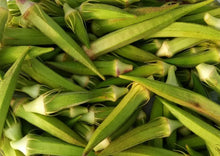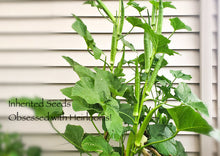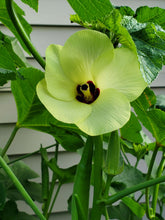
Minimum seed Count: 30
Germination Days: 7-14
Hardiness Zone: 3-10
Planting Depth: 1/2"- 1”
Plant Spacing: 12”
Row Spacing: 24”
Growth Habit: upright
Soil Preference: fertile, rich in organic matter. 6.0 – 7.0 pH
Temp Preference: warm
Light Preference: full sun
Days to Maturity: 55 days
Pests/diseases: Charcoal Rot Fungus, Southern Blight, white mold, Yellow Vein Mosaic, Aphids, Armyworms, Cut earworm, cucumber beetles, loopers, thrips, spider mites
This is a Premium Strain I’ve been saving for many years!!
An heirloom Lousiana Green Velvet (Abelmoschus esculentus) is open pollinated variety. Plant produces good yields of 5 to 8" long spineless dark green okra. The okra remain tender when large. Retains its vibrant color when cooked. This variety does well where temperatures and humidity are high. Excellent choice for home gardens and market growers.
Planting
- You can start okra seeds indoors in peat pots about 3 to 4 weeks before the last spring frost.
- In warmer areas, you can also start okra directly in the garden 3 to 4 weeks before the last spring frost date as long as you cover the plants until the weather warms up fully.
- Plant okra seeds about 1/2 to 1” deep and 12 to 18 inches apart in a row. You can soak the seeds overnight to help speed up germination.
- Okra prefers warm weather, select a location where the plant can receive full sun.
- Okra is adaptable to most soils type, but performs best in well-drained soil that’s rich in organic matter.
- Okra plants are tall, so space out the rows 3 to 4 feet apart.
Care
- Okra prefers constant moisture and weed free. Apply a layer of mulch 2 to 3” high around the plant.
- Apply aged manure, or rich compost as a side dressing
- When the seedlings are about 3 inches tall, thin the plants so that they are 12 to 18 inches apart, if they aren’t already.
- Keep plants well-watered throughout the summer months; 1 inch of water per week is ideal, use more if you are in a hotter region.
- After the first harvest, remove the lower leaves to help speed up production.
Common Okra Growing Problems
- Seeds did not germinate:Soil is not warm enough for germination; soil temp must be at least 70°F for okra to germinate. Pre-soak seeds in water for 24 hours before sowing.
- Plant flowers but pods do not form:Temperature fluctuations can interfere with pollinations. Pollination will be poor if temperatures rise above 90 °F or drop below 55 °F. Too little light, water stress, and excess nitrogen also inhibit pod formation.
- Spots on leaves; spot become circular with gray centers.Leaf spot is a fungus disease. Plant resistant varieties. Rotate crops. Keep garden free of plant debris. Plant in well-drained soil.
- Black water-soaked blotches on stems and leaves:Anthracnose is a fungus disease that spreads in high humidity & rainfall. Leaves may wither and fall. Plant may die back. Remove & discard infected plants. Avoid working in garden when it is wet which can result in spread of spores.
- Plants stunted, leaves yellow, roots decayed:Fusarium root or stem rot is a fungal disease that favors warm soil. Remove infected plants and plant debris that harbor fungus. Rotate crops. Rotate crops regularly. Solarize the soil in late spring or summer.
- Leaves turn yellow and then brown from the bottom up; plant loses vigor:Root knot nematode is a microscopic eelworm that attacks roots. Rotate crops. Remove old plant debris from garden.
- Yellow leaves and curled, shiny specks on leaves: Aphids are tiny, oval, and yellowish to greenish pear-shaped insects that colonize on the undersides of leaves. They leave behind sticky excrement called honeydew which can turn into a black sooty mold. Use insecticidal soap.
- Yellow leaves; tiny white winged insects around plants.Whiteflies will congregate on the undersides of leaves and fly up when disturbed. Remove infested leaves & the whole plant if infestation is serious.
- Holes in pods.Corn earworm is a brown-headed caterpillar with lengthwise stripes to 2 inches long; the adult is a night-flying moth with brownish or olive wings and bright green eyes. The worm will tunnel into pods. Handpick caterpillars and destroy.
- Deformed pods.Southern green stink bug is a light green bug to ½-inch long. Bug sucks sap from leaves and pods causing them to become twisted and deformed. Spray with insecticidal soap.









